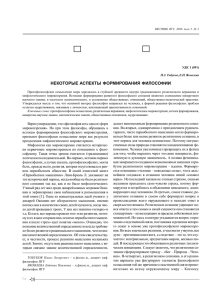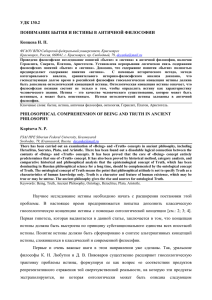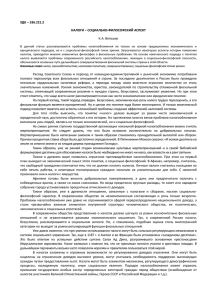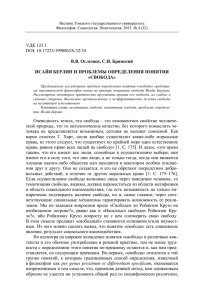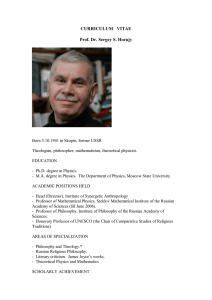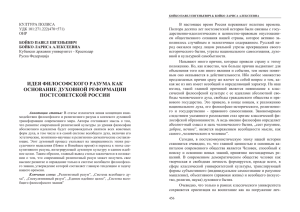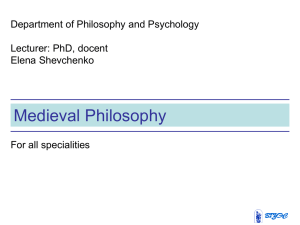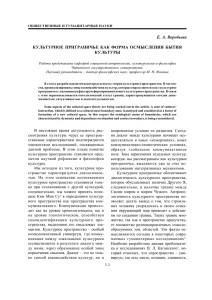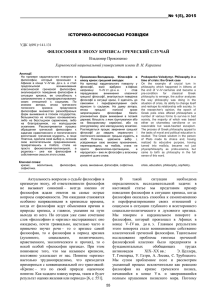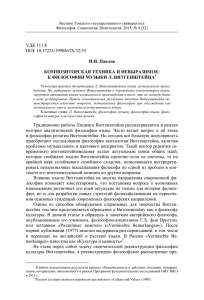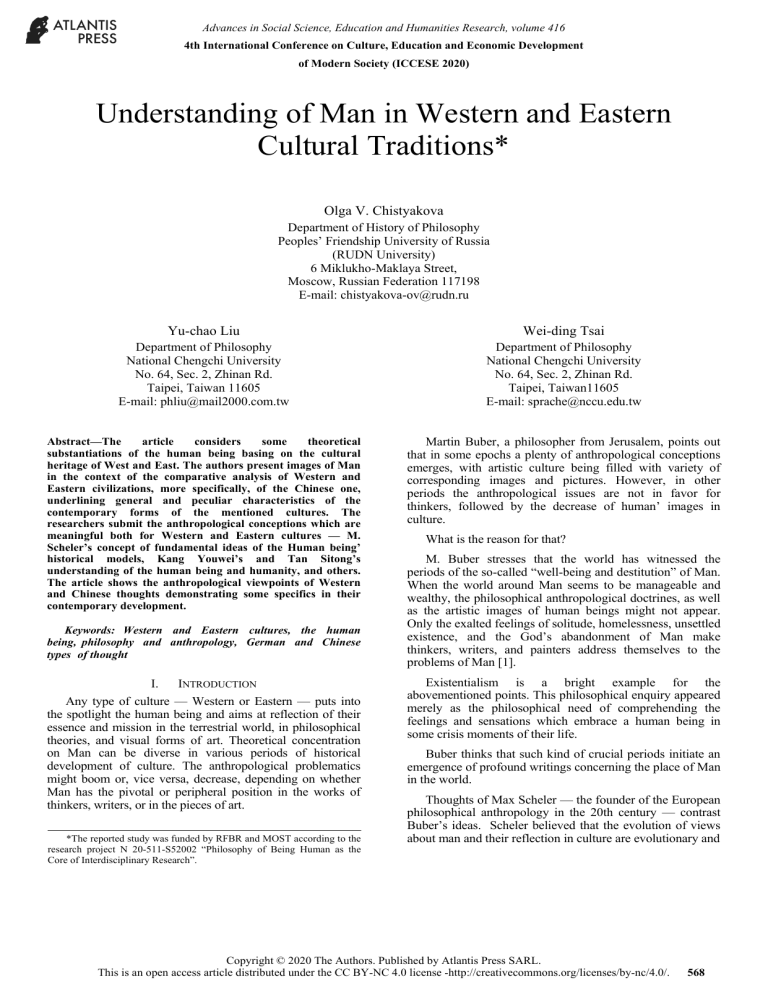
Advances in Social Science, Education and Humanities Research, volume 416 4th International Conference on Culture, Education and Economic Development of Modern Society (ICCESE 2020) Understanding of Man in Western and Eastern Cultural Traditions* Olga V. Chistyakova Department of History of Philosophy Peoples’ Friendship University of Russia (RUDN University) 6 Miklukho-Maklaya Street, Moscow, Russian Federation 117198 E-mail: [email protected] Yu-chao Liu Wei-ding Tsai Department of Philosophy National Chengchi University No. 64, Sec. 2, Zhinan Rd. Taipei, Taiwan 11605 E-mail: [email protected] Department of Philosophy National Chengchi University No. 64, Sec. 2, Zhinan Rd. Taipei, Taiwan11605 E-mail: [email protected] Abstract—The article considers some theoretical substantiations of the human being basing on the cultural heritage of West and East. The authors present images of Man in the context of the comparative analysis of Western and Eastern civilizations, more specifically, of the Chinese one, underlining general and peculiar characteristics of the contemporary forms of the mentioned cultures. The researchers submit the anthropological conceptions which are meaningful both for Western and Eastern cultures — M. Scheler’s concept of fundamental ideas of the Human being’ historical models, Kang Youwei’s and Tan Sitong’s understanding of the human being and humanity, and others. The article shows the anthropological viewpoints of Western and Chinese thoughts demonstrating some specifics in their contemporary development. Martin Buber, a philosopher from Jerusalem, points out that in some epochs a plenty of anthropological conceptions emerges, with artistic culture being filled with variety of corresponding images and pictures. However, in other periods the anthropological issues are not in favor for thinkers, followed by the decrease of human’ images in culture. Keywords: Western and Eastern cultures, the human being, philosophy and anthropology, German and Chinese types of thought I. INTRODUCTION Any type of culture — Western or Eastern — puts into the spotlight the human being and aims at reflection of their essence and mission in the terrestrial world, in philosophical theories, and visual forms of art. Theoretical concentration on Man can be diverse in various periods of historical development of culture. The anthropological problematics might boom or, vice versa, decrease, depending on whether Man has the pivotal or peripheral position in the works of thinkers, writers, or in the pieces of art. *The reported study was funded by RFBR and MOST according to the research project N 20-511-S52002 “Philosophy of Being Human as the Core of Interdisciplinary Research”. What is the reason for that? M. Buber stresses that the world has witnessed the periods of the so-called “well-being and destitution” of Man. When the world around Man seems to be manageable and wealthy, the philosophical anthropological doctrines, as well as the artistic images of human beings might not appear. Only the exalted feelings of solitude, homelessness, unsettled existence, and the God’s abandonment of Man make thinkers, writers, and painters address themselves to the problems of Man [1]. Existentialism is a bright example for the abovementioned points. This philosophical enquiry appeared merely as the philosophical need of comprehending the feelings and sensations which embrace a human being in some crisis moments of their life. Buber thinks that such kind of crucial periods initiate an emergence of profound writings concerning the place of Man in the world. Thoughts of Max Sсheler — the founder of the European philosophical anthropology in the 20th century — contrast Buber’s ideas. Scheler believed that the evolution of views about man and their reflection in culture are evolutionary and Copyright © 2020 The Authors. Published by Atlantis Press SARL. This is an open access article distributed under the CC BY-NC 4.0 license -http://creativecommons.org/licenses/by-nc/4.0/. 568 Advances in Social Science, Education and Humanities Research, volume 416 do not depend on feelings of disadvantage or, on the contrary, self-sufficiency and well-being. According to Scheler, the anthropological reflection relates to the increase of the human beings’ selfconsciousness, attaining its pinnacles upon reaching historical and cultural turning points. Transient historical ups and downs don’t influence essentially the appearance of philosophical and cultural anthropology, nothing changing and adding to their fundamental development. We must comprehend the nature of Man for elaborating the fundamental theory of human being per se. The German philosopher himself tried to explore the essence of Man within the framework of biological anthropological school of philosophy, founded him in the middle of the 20th century. What’s worth noting is that the anthropologism is mainly characteristic of the Western culture [2]. History of the Western cultural tradition witnessed how humanism and anthropocentricism of Renaissance became freighted with additional attention to person in the epoch of Enlightenment, and then subtle interest to the human’s subjectivity appeared in literature and philosophy in the period of Romantism. The romantic viewpoints about Man were substituted for the true belief in the endless possibilities of Homo Sapiens in the 19th century. Mainly, it was determined by boom in the natural sciences and by the new discoveries of the classical period of scientific development. It is extremely difficult to find out the anthropological topic per se in the Eastern cultural tradition. For example, the Old Indian philosophy includes only some particular stories bearing an anthropological content. So-called “solubility” of Man in space reflects the spirit of Eastern Weltanschauung in itself. Indian philosophy tells us about the Vedantic victim of the primal man — Purusha — from whose body the universe was created. This point of Old-Indian thought reveals the conception on the universal soul. The primal man refused from the own uniqueness and oneness for the more important goals’ sake. The parts of Purusha’s body begot the terrestrial world. Thus, for the Indian culture, the Purusha’s image represents the vital principle of all the living things in the world. According to the European thinking, the East is a phenomenon which manifests the model of life essentially different from the West. The usage of the notions “the East” and “the Eastern culture” for a European philosopher sometimes serves as a universal scheme that may be filled up by a diverse content. Thus, a German philosopher J.G. Herder recognizes the oriental world as incarnation of patriarchal and idyllic origins. Georg Hegel, having elaborated the scheme Iran — India — Egypt and using it as the fundamental basis for the history of philosophy, tried to describe the model of the Absolute Spirit’s unfolding in the work “Phenomenology of Spirit”. Taking ideas of Eastern thinkers into account, we may state that their understanding of Man correlates always with the highest, in-personal, values. The thought of this kind tends to describe the power as a reservoir of such values comparable with the divine ones. However, the moral principles of compassion, humanism, kindness, pity, some ethical rituals, relating to the ancestors, parents, and authorities had their roots in the Eastern culture. Confucianism brings such sort of moral values in light in some theoretical works. Worth mentioning that understanding of Man in Western (European) and Eastern cultures differs, with some peculiarities and specific traits in their conceptual reflections. Thus, when considering the anthropological topic within the world culture, we should make allowance for the cultural identity of people and their historical legacy of religious, cultural, philosophical, and ethical viewpoints [3]. By the way of illustration, some religious trends of the Middle East elaborated the conception of Man which is correlated with the Christian teaching. Thus, medieval Sufism elaborated the ways of God-knowing and achieving of a peculiar spiritual state of a person’s unification with God (fana). This path to God is similar in many ways with the cognition of God through the uncreated light of the Christian mystical tradition of the Middle ages. A human being, ascending to God and knowing Him, is represented as a medium between the Divine and mundane worlds in both traditions. For certain, there will always be similarity and difference while judging Western and Eastern cultures, as well as in revealing the place and significance of Man in both. The differences in the approaches to comprehending the essence of Man and realizing the philosophical problems of their existing have been accumulated historically, starting from the mythological explanation of Man. Let’s consider the Western culture comprehension of Man in some conceptions. II. WESTERN CULTURAL TRADITION: MAN AND REASON, MAN AND SPIRIT The contemporary Western tradition of reflecting the place of Man in the world intertwines tightly with the historical philosophical thinking and, first of all, with the reinterpretation of Ancient anthropological issues, being developed in accordance with modern days’ periods and with debated philosophical problems. A French philosopher Blaise Pascal, writing within the cultural religious tradition of the modern history, boosted the Ancient Greek anthropology’s significance, paying attention to the antinomical nature of the human being and their involvement into the transformation of global history. According to Pascal, the nature of Man, as an inherent part of the culture, is a subject of philosophical reflection [4]. Pascal contends that reason is a source of the human’s morality because freedom and intellect a-priory are intrinsic of each person. It was Max Scheler who accomplished the anthropological turning point in the Western culture of the 20th century. Proceeding from the Kantian rationalism and basing on the Ancient Greek philosophical tradition, Scheler objected a cognition of the human being’s essence as the main goal of the philosophical anthropology with its new theoretical desires and a new understanding of Man in the world’s human history. The names of M. Scheler, A. Gelen, 569 Advances in Social Science, Education and Humanities Research, volume 416 and G. Plessner are associated with the origin of the anthropological trend in culture, which has received the significance of the metaphysical, i.e. the school of philosophy itself. It is generally acknowledged that Scheler and Plessner are the founding fathers of the philosophical anthropology as a Western academical discipline of the 20th century. E. Cassirer, E. W. Hengstenberg, A. Gelen, and many other scholars after Scheler used this title defining a particular trend of philosophy, i.e. research of the human and their nature. Scheler and his followers tried to unite many existed conceptions about Man into a logical coherence. Understanding of man as biological entity was a first fundamental point. Stemming from this idea, they intended to achieve exactly the philosophical reflection on human being. They opposed their doctrine to pragmatism, psychoanalysis, structuralism, and others philosophical schools of the West. Revealing the biological nature of the human being, the representatives of the philosophical anthropology endeavored to apply their peculiar knowledge to learning of culture, morality, social institutions, and so on. According to Scheler, the gradual comprehension of the essence of Man is tightly connected with knowing of humanity’s self-consciousness and the main types of anthropology. In his book “The Human Place in the Cosmos” M. Scheler has formulated the vast theory of philosophical cognition of the human being in their substantial completeness of being. He elaborated three general fundamental ideas of Man and significance of human being’s appearance in the Cosmos and in history. These everlasting ideas derived respectively from the Ancient Greek philosophy, the Judeo-Christian religious doctrines, and evolutional theories. He writes that every “educated European” can reveal “three irreconcilable ideas about the term [human being - authors O.C., L.Y., T.W.], which are in continuous conflict with each other. First, there is the thought of the Jewish-Christian tradition about Adam and Eve, and of creation. Second, there is the thought stemming from the ancient Greeks when the human being’s consciousness of himself raised him for the first time into a special place, realizing that the human being is what he is through his possession of what is variably called “reason”, “logos”… Closely connected with this view is the theory that there is also a reason above the human being alone is in a state of participation. Third, there is the thought of natural science and genetic psychology, today already a tradition. According to this theory, the human being represents a late stage in the evolution of our planet” [5]. Scheler aimed to analyze all the conceptions within the theological, philosophical, and scientific meta-ideas and create a new anthropology providing us with the common theoretical foundation. Relying on this foundation, the Western culture faced the anthropological revolution, having many thinkers’ cherished desire to develop a new understanding of the human being. Let us pinpoint some of Scheler’s anthropological concepts that affected on the Western culture. He stems from the justification what the human being is, and points out that it is Man, who, being a living creature, has possessed features which bring them and animals together. The relation is so colossal that the human being has been seeking the substantiation for their difference from the animals for centuries. The most important goal of the created Western anthropology is to find out the distinctions between Man and animal. The German philosopher has achieved that difference, identifying its sources already existed in Ancient Greek philosophy. He stresses: “This new principle is beyond what we call “life” in the widest meaning of the word. … The new principle is, first of all, opposite anything we call life, including life in the human being: it is a genuinely new, essential fact which cannot at all be reduced to the “natural evolution of life” [6]. The Ancient thought equated a notion of “spirit” with a category of “reason”. Following Scheler, a person can become a personality due to spirit. Here Scheler contradicts the materialistic viewpoint. Spirit rather than society contributes to the development of an individual ascending to the lofty place of personality. Exactly spirit allows Man to differ from animal, as the human being is a priori granted by the Divine origin, i.e. reason, which is opposed to the nature per se with its lack of rationale and mind. The human being is “the sole bearer” of spirit in the Universe. Man is inherently included in the process of spiritualization of the humanity. At the level of spirit, the human being obtains the highest values — moral, religious, cultural — given to them at the definite historical period and place. The human beings live to realize their aim and mission in the Universe, and constantly identify their special place in the Cosmos. Man conceives themselves on the ground of comparison and separation from the other parts of reality as well as Man is aware of their belonging to the wholeness, i.e. the Universe. It means that the human being needs of anthropology and creates it for the own understanding of their life. There is no anthropology among the animals because all the species lack self-consciousness. Only Man, possessing of mind, self-consciousness, and reason, is able to produce anthropology. According to Scheler, the sciences are rooted in the anthropological interest which every human being keeps toward to the own entity. Thus, the anthropology holds a significant place among the other sciences. M. Scheler correlates anthropology with the religious understanding of Man. God is embraced by the spirit and reveals the highest form of sacred being. The religious spirit is a mean of unity of spirit and sensibility, while as Man is a place of their meeting. The human being is deeply aware of their likeness to God, and in this sense the relationship of God and Man is originally a matter of course. The divine nature of Man is a safeguard of impossibility to return to the state of savageness. 570 Advances in Social Science, Education and Humanities Research, volume 416 Consequently, following Scheler, the meta-idea of a “religious person” is one of the fundamental types of the anthropological conception in history of Western culture. III. EASTERN CULTURAL TRADITION: CHINESE VIEWPOINTS REGARDING THE HUMAN NATURE Since the Qing dynasty (1644-1911) of China got involved in the Opium Wars and was defeated by Great Britain and French in the mid-19th century, China was forced into the process of modernization and began to learn Western knowledge and institutions. After China lost to modern Japan in the First Sino-Japanese War of 1894-1895, Chinese intellectuals demanded more radical reforms by the Qing court. The Emperor Guangxu ( 光緒帝 ), whose reign period was between 1871-1908, adopted suggestions from Chinese philosopher Kang Youwei (康有為) and undertook a political reform in 1898, which historians call the “Wuxu Reform” (戊戌變法)1. Although this reform movement ended in failure, its impact on China's modernization is significant. Some activists in this reform movement, including Kang, Yan Fu (嚴復 )2 , and Tan Sitong (譚嗣同), tried to combine Western knowledge with the Chinese traditional thinking to establish their own theories of humanity, in order to support social and political reforms in China around the late 19th century and it thus influenced the subsequent development of contemporary Chinese views on human nature to a certain extent. A. Kang Youwei on the human nature and the great unity Kang was the leader of the reform movement of 1898. He was schooled in Neo-Confucianism of the Sung-Ming Period, Taoism, and Buddhism, since he was young. He also read many translations of Western writings concerning religion, geography, technology, and natural science during 1880s. Then Kang initially formed his own philosophy of humanity. Firstly, Kang argued that every nature (性) is the innate character of creatures and is neither good nor bad [7]. Human nature or humanity is the natural desire of human, including the desire for pleasure and avoidance of suffering [8]. With regard to human nature, Kang referred to the famous debate between Gaozi ( 告 子 , 420-350 BC) and Mencius (孟子, 372-289 BC) about the morality of human nature and approved Gaozi’s doctrine — and thus disagreed with Mencius’ doctrine and his successors in the Song dynasty of China [9]. In Mencius’ view, it is the inherent moral character of human nature that distinguishes human from other animals. And some Neo-Confucians of the Song dynasty followed his viewpoint and divided the human nature into two parts, namely the “nature from heaven and earth” (天地之性) and the “nature from Chi” (氣質之性) [10]. 1 The Wuxu Reform was intended for constructing new institutions of education, economics, military, and politics and thus to promote the constitutional monarchy in China. This movement lasted only about one hundred days, therefore it was also named the “Hundred Days’ Reform”. 2 Yan made a great contribution to China’s modernization by translating many Western famous works into Chinese, including Thomas Henry Huxley’s Evolution and Ethics, Adam Smith’s The Wealth of Nations, and John Stuart Mill’s On Liberty. According to these Neo-Confucians, the former is the moral character which is endowed to a person by heaven a priori and is purely good as such; the latter is the physical character which is amoral by birth and can be performed in a good or bad way afterwards. Like Gaozi, Kang denied that human nature is inherently good. According to Kang, human nature is simply nature from Chi, and all moral characters of human beings come a posterior, therefore we can’t divide human nature into two parts. Consequently, the moral characters — or so called “heavenly principles” (天理) — are not inborn, but only right of freedom which can help to realize ideal humanity [11]. Based on this understanding of human nature, Kang quoted a phrase from Confucius (551-479 BC) — namely “By nature, men are nearly alike” (性相近 ) — and thus claimed that humanity is equal [12]. In another word, since human beings are born about the same, we can’t say that some of them are born to be morally and/or socially greater and others are lesser. With this thought, Kang was opposed to the feudal morality and tried to challenge the traditional social order. Secondly, for Kang, humanity can also be manifested in expressions of “benevolence” ( 仁 ). Although benevolence, according to Mencius, is the “mind that can’t bear to see sufferings of others” (不忍人之心) [13] and everyone has it by birth, Kang considered benevolence not only as the virtue of charity, but also as the principle of life and growth in nature. For him, benevolence is the force of love which consists of electricity and ether (以太). It seems that benevolence is for Kang a spiritual character as well as a material element which constitutes universe. We might say that Kang saw some similarities between benevolence and electricity and thus equate benevolence further with electricity by combining Chinese philosophy with Western physics dogmatically — although simply under some misunderstandings. Lastly, Kang suggested in his The Book of Great Unity in 1901 that the traditional ideal of cosmopolitanism — or “the Age of Great Unity” (大同世 ) — will finally come true, if everyone can enhance their benevolence and fulfill their natural desire. In such an ideal world, there would be no more distinction between classes and races, no need for private property and no need for national borders, and all human beings would attain to happiness, be free from suffering and love each other. In short: When human nature can be actualized completely, human society will eventually evolve into a society of great harmony. Accordingly, this “Age of Great Unity” is undoubtedly the destination of the Wuxu Reform which Kang with his philosophy of humanity promoted. B. Tan Sitong on benevolence as the human nature Besides Kang, TAN Sitoung is also an important member of the Wuxu Reform of 1898, and his understanding of human nature also reflects the same pattern of intercultural interpretation at that time. As we know, Tan learned Kang’s idea about political reform through a pupil of Kang, LIANG Qichao ( 梁啟超 ). 571 Advances in Social Science, Education and Humanities Research, volume 416 Tan was totally convinced by Kang’s philosophical thought and thus regarded himself as a pupil of Kang. That is the reason why there are similarities between their theories of humanity. We can even say that Tan refined Kang's theory of humanity. In Tan’s major work, An Exposition of Benevolence (仁 we can find out that his thinking is originated from traditional Chinese philosophy (especially Confucianism and Buddhism), Christian doctrines and Western nature science and merges the three together in a way similar to Kang. 學 ), At first, Tan based his philosophy of humanity on a theory of ether which was originally proposed by a Scottish scientist, James Clerk Maxwell (1831-1879). Maxwell supposed that ether exists everywhere in the universe and is the medium of every matter so that both light wave and electromagnetic wave are possible through it. In the late Qing dynasty, this theory of ether was introduced by the Chinese intellectual Yen Fu mentioned above and an English sinologist John Fryer (1839-1928) who named himself in Chinese as Fu Lanya (傅蘭雅). Then Tan appropriated it into his philosophy and regarded ether as the ultimate element of all chemical elements. According to Tan, ether is the basic element or atom of everything — whatever it is “material” or “spiritual” — and is neither created nor destroyed. Besides, the Nature for him is only a function of ether. Like Kang, Tan claimed that every inborn thing is created by the Nature, for example, our human body and appearance given to us is from the Nature [14]. In this sense, the Nature as such is neither good nor bad. But since ether has a uniting power to bring everything to completion and cohesion, Tan concluded that the Nature can thus be regarded also as good in a certain degree [15]. It is the uniting function of ether that resembles the human benevolence or love. So Tan identified ether with benevolence, and hence with the human nature. His idea can be elucidated as follows — although he had a lot of misunderstandings: When ether manifests its functions in the universe, Confucius saw it in the form of “benevolence”, “ultimate source” (元) and “nature”, Mozi (墨子, 468-376 BC) called it “love without discrimination”(兼愛), Buddha named it “the ocean of nature” (性海) and “compassion”(慈悲), Jesus meant it with expressions such as “soul” or “you should love your neighbor as yourself”, and natural scientists called it “centripetal force” and “gravitational force” [16]. In short: Although benevolence or human nature as such is eventually value-neutral, it can be called “good” from the viewpoint of human beings. Then Tan hold that human passion can also be called good, since it belongs to human nature and the latter is now called good [17]. In his view, the terms such as “evil” and “good” are only names, so something called evil could be called good in another circumstance. When we say something is evil or bad, this just means that it doesn’t follow its existing order and doesn’t means that it is essentially evil. Therefore, if we can say that human nature is good, so we can say that human passions and desires are good, too. In order to illustrate the relation between human nature, which equals the heavenly principles and human desires, Tan cited a remark from WANG Chuanshan (王船山, 1619-1692) 3 as evidence: “The heavenly principles lie in human desires; without human desires, there is nowhere in which the heavenly principles can manifest themselves” [18]. On the basis of this standpoint, Tan criticized the traditional morals in Chinese society which are called “three cardinal guides and five human relationships” ( 三 綱 五 倫 ). Briefly speaking, the three cardinal guides mean “sovereign is the guide of his subjects” (君為臣綱), “father is the guide of his son” (父為子綱), and “husband is the guide of his wife” (夫為 妻綱 ); and the so called “five human relationships” refer to 5 kinds of ethical relationship, namely the relationships between sovereign and subjects, between father and son, between husband and wife, between brothers, and between friends. According to Tan’s remark, the “three cardinal guides and five human relationships” have been usually used for thousands of years by those, who were superior, to control or oppress the inferiors. The superior asked his inferiors to obey his orders as guidelines of behaviors in his family, society and state and regarded obedience as an ethical virtue. For Tan, traditional Confucian virtues such as “loyalty” (忠 ) and “filial piety” (孝 ) are only empty words which are used by superiors to rule and demand their inferiors [19]. These “virtues” are only one-sided morals of superior, but not a really interactive ethical relationship between superiors and inferiors, since superiors don’t face up to desires of inferiors. In order to overthrow those rigid traditional virtues, Tan advocated his concept of benevolence strongly and elaborated on its fundamental meaning in detail in An Exposition of Benevolence. According to what he wrote in the outline of this book titled “Twenty-seven Definitions” (二 十七界說 ), the most fundamental meaning of benevolence is “interconnectedness” (通 ). Interconnectedness can manifest itself in four relationships, i.e.: Interconnections between China and the rest of the world, between higher and lower, between male and female, and between self and others. Besides, Interconnection means equality and equality means that all beings are a united one. When there is oneness, there is interconnection; and when there is interconnection, there is benevolence [20]. Tan’s motif here is as follows: If human beings can treat each other equally, then all peoples can be integrated into a unity. Consequently, human beings can “break through enmeshing restrictions” ( 衝決網羅 ), e.g. be liberated from unfair toils of profit and wealth, of autocracy and of human relations [21]. Once human beings break away from those rigid and unequal social norms and relationships, they will finally conform to the real benevolence and realize their human nature. IV. CONCLUSION We may contend that Western culture in its conceptual reflection of Man relates to the Ancient Greek tradition, with 3 WANG Chuanshan is the pseudonym of the Confucian WANG Fuzhi (王夫之 ), who was alive between the late Ming dynasty and the early Qing dynasty. As we have known, Tan likes to study WANG Chuanshan’s works and is influenced by his thinking strongly. 572 Advances in Social Science, Education and Humanities Research, volume 416 its contemplation of soul and reason as the main ground of human’s essence. The conceptions of M. Scheler and Martin Buber are demonstrated it in the best way. There are notions of self-consciousness, spirit, reason, which have been used by the Western thought, firstly, for justification of gist and specific character of the human nature. Moreover, self-consciousness and spirit are the theoretical means exercising by M. Scheler and his disciples in the 20th century for explanation of the identity “of the human being in his relation to plants and animals” [22], as well as for the development of culture and types of spirituality. For certain, Scheler and other representatives of the Western culture could have considered the human being only with the religious foundation. Thus, the “religious idea” of Man became the major thesis in interpretation of the Western culture progression. The Eastern culture, in particular, the Chinese one, were mostly connected with the own historical and philosophical legacy. Nevertheless, it didn’t reject the Western culture and sometimes they even were converging on some issues as it occurred in the theories of Kang and Tan, the important Chinese thinkers. In view of the lasting crisis of their nation in the late 19th century, many Chinese intellectuals strived to rebuild the social-political system of China. Their philosophy, including philosophy of humanity, is the basis of their proposals to reform. Kang and Tan are two representatives of them. They absorbed new thoughts from the Western culture, especially Western scientific knowledge, and tried to combine it with traditional Chinese thinking. Kang’s and Tan’s philosophy of humanity appropriates Western modern physics to suggest that human nature as such is inherent and neither good nor bad. Accordingly, human morality is acquired a posterior and should not departs from human desires and emotions. This doctrine was opposed to the main stream of Confucianism in China. Kang and Tan challenged the traditional ideology, in which they were schooled, and developed their own understanding of human nature, because they wanted to advocate the idea of innate equality and thus to resist unfair ethical codes and the political system which made lower class suffering. [4] [5] [6] [7] [8] [9] [10] [11] [12] [13] [14] [15] [16] [17] [18] [19] [20] [21] [22] Blaise Pascal. The Thoughts of Blaise Pascal, translated from the text of M. Auguste Molinier by C. Kegan Paul (London: George Bell and Sons, 1901). Online]. Available from: https://oll.libertyfund.org/titles/pascal-the-thoughts-of-blaise-pascal [Access: January, 24. 2020] Max Scheler. The Human Place in the Cosmos. Northwest University Press. 2009, p. 5. [Online]. Available from: https://books.google.se/books?id=WxcZ7D1cvlkC&pg=PR19&lpg=P R19&dq=scheler+The+Human+Place+in+the+Cosmos+full+text&so urce [Accessed 04 February 2019]. Ibid. p. 26. KANG Youwei, Lectures of the Wanmu Thatched Hall (萬木草堂口 說), in: Collected Works of Kang Youwei (康有為全集), edited by Jiang Yihua (姜義華) and Zhang Ronghua (張榮華), Vol. 2, Beijing: China Renmin University Press, 2007, p. 166. KANG Youwei, The Book of Great Unity: A Modern Utopia under the Traditional Coat ( 大 同 書 : 傳 統 外 衣 下 的 近 世 理 想 國 ), commented by LI Sizhen (李似珍), Zhengzhou: Zhongzhou Ancient Books Press, 1998, p. 38. KANG Youwei, Lectures of the Wanmu Thatched Hall and Changxing Handouts ( 長 興 學 記 ), in: Collected Works of Kang Youwei, Vol. 2, p.186 and Vol. 1, p. 363. In short, Gaozi argued that life is what is called nature and nature is neither good nor bad. Those Neo-Confucians include CHENG Yi ( 程 頤 , 1033-1107), CHANG Tsai (張載, 1020-1077), and CHU Si (朱熹, 1130-1200). Kang, The Book of Great Unity, p. 174. Cited by KANG Youwei, Changxing Handouts, in: Collected Works of Kang Youwei, Vol. 1, p. 363. And his quotation comes from Analects, 17: 2. Cited by KANG Youwei, Esoteric meanings on Mencius (孟子微), in: Collected Works of Kang Youwei, Vol. 5, p. 414. And his quotation comes from Mencius, Book 2A. Tan Sitong, An Exposition of Benevolence: the "Jen-hsüeh" of Tʻan Ssu-tʻung, translated by Chan Sin-wai, Hong Kong: The Chinese University Press, 1984, p.80. Ibid. Ibid, p. 67. Ibid, p. 81. Tang, An Exposition of Benevolence, p. 81. Ibid, p. 78. Ibid, pp. 61-64. Ibid, pp. 57-58. Max Scheler. The Human Place in the Cosmos. Northwest University Press. 2009, p. 6. [Online]. Available from: https://books.google.se/books?id=WxcZ7D1cvlkC&pg=PR19&lpg=P R19&dq=scheler+The+Human+Place+in+the+Cosmos+full+text&so urce [Accessed 04 February 2019]. REFERENCES [1] [2] [3] Martin Buber. The Problem of Man. M.: Republic. 1995. Sergei Nizhnikov. Igor Grebeshev. Philosophical Comprehension of Culture and Human Essence // 2nd International Conference on Contemporary Education, Social Sciences and Ecological Studies (CESSES 2019). Advances in Social Science, Education and Humanities Research, volume 356. Paris: Atlantis Press, pp. 11771180. Olga V. Chistyakova. Denis I. Chistyakov. Interrelation of Philosophical and Religious Values of Russia and the USA: Historical and Cultural Context // Proceedings of the 5rd International Conference on Education, Language, Art and Inter-Cultural Communication. (ICELAIC 2018). Advances in Social Science, Education and Humanities Research. Vol. 289. Paris: Atlantis Press, 2018, p. 742-744. 573
